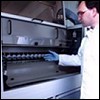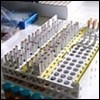|
||||||||||

TOBACCO/SMOKING
 Exposure to Tobacco Smoke and Harmful Substances in Tobacco
Exposure to Tobacco Smoke and Harmful Substances in Tobacco
Biomonitoring also has been the driving force for assessing people's exposure to environmental tobacco smoke (ETS), which has been identified as causing cancer in people. Children are at particular risk for harm from ETS, which may aggravate asthma in children who have the disease and greatly increase the risk for bronchitis and pneumonia among young children.
The best way to measure individual exposure to ETS is to measure levels of a chemical called cotinine. This chemical is a metabolite of nicotine and is regarded as the best biological marker for tobacco smoke exposure for both smokers and nonsmokers exposed to ETS. People with higher cotinine levels have had more exposure to tobacco smoke than people with lower levels.
 When CDC developed a method for measuring very low levels of cotinine in the U.S. population, it found that 88% of the population was exposed. Data were unavailable to document that people who thought they were exposed to ETS in the workplace actually had such exposure. CDC's study showed that people who reported more exposure to ETS in the workplace had measurably higher levels of cotinine, indicating higher actual exposure. These unique data provided important justification for establishing regulations restricting smoking in public buildings.
When CDC developed a method for measuring very low levels of cotinine in the U.S. population, it found that 88% of the population was exposed. Data were unavailable to document that people who thought they were exposed to ETS in the workplace actually had such exposure. CDC's study showed that people who reported more exposure to ETS in the workplace had measurably higher levels of cotinine, indicating higher actual exposure. These unique data provided important justification for establishing regulations restricting smoking in public buildings.
When cotinine levels in the U.S. population were measured again in 1999 and 2000, median cotinine levels among people aged 3 years and older had decreased at least 70%. This dramatic reduction is an important public health success; however, because approximately half of all American youth are still exposed, and because children's levels are still twice those of adults, ETS remains a major public health concern.
CDC's Environmental Health Laboratory scientists are taking part in many studies related to tobacco and tobacco smoke. Two of these studies assessed exposure to ETS among infants by measuring levels of cotinine in their urine. In one study, the laboratory measured cotinine levels in infants who, with their mothers, were enrolled in the Women, Infants, and Children (WIC) Supplemental Food Program in San Diego County, California. In the other study, infants were enrolled in a clinic-based program in the same region. The purpose of both studies was to evaluate the effectiveness of a behavioral counseling program designed to reduce maternal and infant exposure to ETS in the home. Another goal is to examine the effects of this intervention program on the smoking behavior of mothers in the study. The laboratory data provided biological confirmation of the effectiveness of the intervention and information about levels of exposure to cotinine in the infants.
CDC's Environmental Health Laboratory also analyzes tobacco products and cigarette smoke for the presence of harmful substances and for substances that may influence the delivery of harmful substances to the body. For instance, the laboratory not only investigates the concentration of nicotine in cigarettes and smoke but also the factors or chemicals that influence the delivery of nicotine to people. In addition to nicotine, these harmful substances include nitrosamines; tar; pesticides; carbon monoxide; volatile organic compounds (benzene, for example); metals (such as cadmium and radioactive polonium); carbonyl compounds; and polycyclic aromatic hydrocarbons. Again, the laboratory's expertise in biomonitoring has been essential for determining the actual doses of many of these substances that get into people.
For More Information...
CDC Resources
U.S. Federal Government Resources
Non-Federal Resources